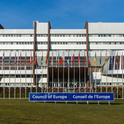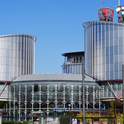Last March, I travelled to Burma's new capital, Nay Pyi Daw. I was among a handful of journalists to be invited to the junta's annual military parade. It was the first time that the outside world had been granted a glimpse of the city the generals have built. Dumped in the middle of malarial scrubland, some 300 miles north of Rangoon, it is a strange, gleaming confection of official hotels, ministries and government housing set in the baking plains of central Burma (now called Myanmar). The junta has spent billions building this largely empty metropolis—whose name means "Seat of Kings."
Here, the generals sit in perfect isolation while the rest of the country suffers. Spending on healthcare is, according to the UN, the lowest in the world. Poverty is widespread and a third of children under five are malnourished. Military spending, though, has rocketed. Despite chronic power shortages, leaving much of the country in almost permanent blackout, the junta's new capital gleams with 24-hour electricity.
When I first arrived in the old capital, Rangoon, on a photographic assignment in 1995, I expected steel helmets and fixed bayonets at every street corner and endless checkpoints—all the sights one associates with military dictatorships. Instead I found a bustling metropolis of colourful markets, packed restaurants and gleaming pagodas. Street hawkers were selling old copies of Life magazine and monks browsed the book stalls next to tea shops. The Burmese army was conspicuous by its absence. I had to "steal" images of soldiers I did see, and often they would hold their hands in front of my lens to stop me. Now, here in Nay Pyi Daw, I was surrounded by thousands of them. And I was permitted to photograph at will.

There is a saying in Burma that the only colours on state-run television are green and orange: green meaning the military, orange the monks. Every day, the population is bombarded with images of generals kneeling in front of impassive monks, handing over alms in the form of hampers of soap, biscuits, silk robes and other goodies. This is what passes for news in Burma. In this devoutly Buddhist nation, giving alms is one way the military demonstrates their Buddhist credentials and, by extension, legitimise their place as the country's rulers. Many outside commentators suggested that the army would never dare use violence against the Sangha (Buddhist clergy). Any violent response by the military would be seen by ordinary people as a deliberate attack on the most sacred institution in the country. How wrong they were.
The September protests were the most significant since 1988, when the military violently crushed a student-led revolt, killing and injuring thousands. As in 1988, the protest was sparked by economic hardship: this time, the junta announced a 100 per cent rise in fuel prices. It was led at first by former student activists, who were quickly arrested. Then the monks began their protest, many of them refusing alms from those connected to the military by holding their bowls upside down—the Buddhist equivalent to excommunication. The troops quickly went in. Heavily armed soldiers began raiding monasteries, accompanied by police carrying American-made M16s. Scores were killed; thousands were arrested. Within days it was over. The junta admitted to nine deaths; other estimates put the toll in the hundreds.
Back in control, the junta seems as entrenched as ever. It dominates every sector of Burmese society. Since the crackdown, soldiers have vanished from the streets almost as quickly as they appeared. Rangoon is once again busy, but it is a normality underscored by fear. At night, the raids continue. The brutal crushing of the protest was greeted around the world with outrage. But outrage is not enough to bring about change. At some point, the world is going to have to deal with the generals. But what do we really know about the Burmese military and its worldview?
***
The Burmese army—or Tatmadaw—is a product of the second world war and, specifically, of the Japanese imperial army. Before the Japanese invaded Burma in 1942, a Burmese student activist named Aung San made contact with them, believing they would help deliver Burmese independence from the British. Aung San recruited independence fighters and, after the Japanese defeated the British and took over the country, they created the Burma Defence army, along with civil organisations designed to guide Burma toward independence. A force of 3,000 men was recruited and trained by Japanese instructors. But when it became clear that the Japanese had no intention of granting independence, Aung San and his men turned against his former allies and joined his former foes, the British. Armed Forces day, the most important date in the junta's calendar, marks the date in 1945 when the what was then the Burma National army revolted against the Japanese. Aung San later negotiated Burma's independence from Britain. In 1947, just before it was granted, he and most of his cabinet were assassinated by a rival, U Saw.
Aung San's memory is still revered by many. But today it is something of an embarrassment to the military establishment. Aung San believed that the army had no business being involved in politics. His portrait, which used to hang in homes and shops, has gradually disappeared from view. Even the banknotes no longer carry his image. His daughter, opposition leader Aung San Suu Kyi, has openly challenged the legitimacy of the regime, describing the current impasse as "the second struggle for independence." The mere mention of her name apparently sends the junta's leader, Than Shwe, into a fit of anger.
For the outside world, Burma's woes are represented by the image of Suu Kyi and her stand against the dictatorship. But this is an oversimplification. Her compelling good vs evil battle with the military has obscured another conflict that is vital to understanding the military's role—that between Burma's ethnic minorities.
Burma is one of the most ethnically diverse countries in the world, with over 100 distinct ethnic groups. The main groups—the Mon, Chin, Shan, Kachin and Karen—live in mountainous areas. The Burman majority have traditionally lived in the plains. The suspicion between the lowlanders and the highlanders runs deep. When the British ruled Burma, minority groups like the Kachin became the majority in the army. These peoples were favoured over the Burmans, and considered more "martial." During the second world war, many of the ethnic minorities sided with the British against the Japanese. The Burmans, meanwhile, joined initially with the Japanese and there were several reprisal massacres of ethnic Karen. The fact that some of these ethnic groups were also Christian, unlike the Buddhist Burmans, fuelled a resentment that continues to this day.
The Burmese civil war is one of the longest running in history. Immediately following independence from Britain, Burma was faced with a daunting number of insurgencies, ethnic and otherwise: the Karen, the communists, the Kachin, the Shan, the Pa O, the Kokang and the Koumintang. It looked as though the country might collapse. Mandalay, Burma's second largest city, was occupied for a time by the Karen and the Burmese Communist party. The communists were well armed and had the potential backing of China. The military believed that only a strong army could hold Burma together. This fear of fragmentation has driven the continuing conflict—and the military's massive build-up of reserves.
Nevertheless, in the immediate post-war period, under prime minister U Nu, Burma was a relatively open, if impoverished, country. There were free elections and a free press. But by the late 1950s, the government was plagued by competing interests and corruption. In 1962, General Ne Win, himself a product of Japanese militarism, overthrew the elected government in a coup. He then launched the disastrous "Burmese Way to Socialism," and Burma quickly fell into shadow. His programme embodied both Marxist and Buddhist influences. One of its main aims was to avoid Burma being dragged into the cold war struggles of the region, and to this end Ne Win pursued a policy of isolation. Most private property was confiscated, all dissent was crushed and opponents of military rule were jailed. Over time, the various insurgencies were pushed back to the mountains and forested borders. The army became a state within a state, an insular society in which military men dominated every sphere of Burmese life.
The war continues today in Burma's outlying regions. The military enforces a scorched-earth policy in areas where ethnic insurgents operate, creating 1m refugees. Villagers are press-ganged into carrying supplies to the front or used as human minesweepers. This campaign of terror is believed to be part of a plan to rid the area surrounding the new capital of insurgents.
The army's organisational structure and command style is directly derived from the Japanese imperial army, which trained the founders of the Tatmadaw. (Many of the generals trained by the Japanese remained in place until the 1970s.) Like the Japanese army, the Burmese military relies on highly centralised control coupled with a rigid discipline and an absolute obedience to authority. This contrasts with its impunity in the field, where atrocities are routinely committed. The unquestioning attitude to authority, in a deeply conservative society, has contributed to the military's long domination.
Even so, the reality of Burma's army can be less than impressive. The first time I met Burmese troops was in 1992. I was travelling through insurgent territory near the Thai-Burma border controlled by the Karen. They paraded a group of young men and boys in front of me. They were all army conscripts who had allegedly participated in atrocities before being captured. All had malaria, and some were suffering from beri-beri and were visibly malnourished. They were clearly very afraid. They were a pitiful sight and a far cry from the soldiers before me on the parade ground at Nay Pyi Daw. Soldiers of the lower ranks are often forcibly recruited, kidnapped from their villages and streets. They are then sent for rudimentary training before being dispatched to frontline areas. Corruption and nepotism is widespread. Morale is low and the army is plagued by desertion.
***
The generals who rule Burma today have little concept of the world beyond the country's borders. They have no understanding of economics, of the internet or global markets. When an ambassador from an Asian country had a meeting with some high-level generals in Rangoon recently, there was no interpreter present. The two generals nodded politely as the ambassador spoke to them. It then occurred to him that that neither of them understood a word he was saying. They didn't have an interpreter present because they didn't want to admit to not speaking English. This is an army that has been reared on "internal and external threats," on long experience of jungle warfare and a self-imposed isolation. So when a highly educated woman like Suu Kyi talks to them of democratic and human rights, it is not a language the generals understand. It is a loss of face, particularly when the woman is the daughter of the national hero and the army's founding father.
The global campaign for human rights and democracy in Burma is one of the largest and most organised in the world. Not since the days of apartheid in South Africa has there been such interest in a cause of a single country. Despite all this attention, there is little in the way of consensus about how to bring about change. Isolation, the policy favoured by the international community, hasn't had the desired result. Burma remains a military state. Apart from a vague notion of democracy, there is little debate about an alternative and virtually no idea of what would fill the gap if the military were to step aside, or worse, fragment. Moreover, there are many soldiers and officials who are sympathetic to reform. Members of the armed forces joined the protests in 1988. One former Burmese soldier told me that he reckoned more than half of the army supports Suu Kyi. To continue to demonise the military will only force them to dig in further. And as long as China, India and Russia have a stake in Burma's economy, trying to isolate the regime won't make much difference. The military have to be a part of any solution. This is something Aung San Suu Kyi has always maintained.
***
After years of working in Burma, it was strange to be invited into the heart of the generals' world. Here I was in Nay Pyi Daw, mingling with the people I had read and heard so much about. Had they known I had photographed Aung San Suu Kyi and been to rebel-held territories on numerous occasions, it is almost certain that I wouldn't have been invited. What struck me was how ordinary they appeared. They seemed self-assured and paid scant attention to their foreign guests.
The decision to move the capital from Rangoon has been the subject of much speculation. One theory is that the move was prompted by the junta's fear of invasion by the US, particularly in the light of Afghanistan and Iraq. Nay Pyi Daw is centrally located and adjacent to parts of the country where insurgents still operate. By moving the capital to this area, the regime would be able both to deal with the rebels more effectively and better defend the country against invasion. The new site also has historical significance as the place where the Burma Independence army was based.
After the troops stood to attention in formation, there was silence as they waited for Than Shwe, their supreme commander, to arrive. A gleaming black stretch Mercedes drove up, and there was Burma's dictator, his head and shoulders poking out of the sun roof, his hands stretched out in front holding on to specially made bars to steady him. He didn't move and looked directly ahead. I was reminded of El Cid fastened to his horse to lead his army into battle. On either side of the bonnet were two Burmese flags above a licence plate of five golden stars on a red field.
Than Shwe took to the podium and stood in the morning sun, flanked by officers with swords. Without faltering, he delivered a speech rebuking countries, like the US, that have taken the junta to task over its human rights record. He showed few signs of his reported ill health. "Judging from lessons of history," he said, his voice echoing over thousands of helmeted soldiers, "it is certain that powerful countries wishing to impose their influence on our nation will make any attempt in various ways to undermine national unity." He went on to remind his troops of how the British had practiced a divide and rule policy among the ethnic groups, which enabled them to keep control of the colony, and likened the outbreak of hostilities within the country to "unfastened bamboo poles falling apart." He ended his speech with a vow to crush "internal and external destructive elements obstructing the stability and development of the state"—a statement whose sincerity he got the chance to demonstrate some six months later.
His speech over, General Than Shwe left the podium and inspected his army from the sun roof of his Mercedes. He was then driven out of the parade area, the troops following on foot and the generals leaving in their own smart cars. I and my fellow journalists were whisked away and taken on a whirlwind tour of the capital in a flashing convoy that never stopped. I left Nay Pyi Daw as soon as I could. There seemed little point in staying in this Potemkin city.











